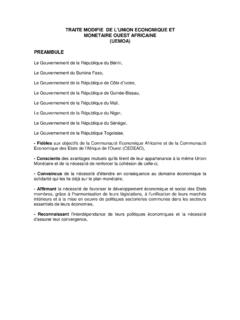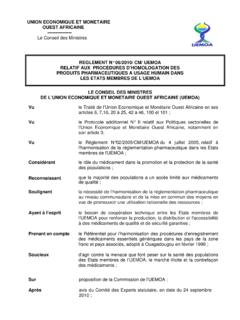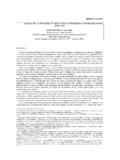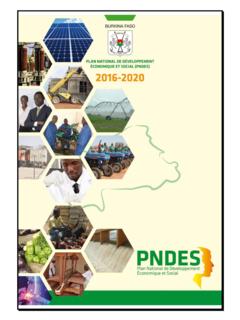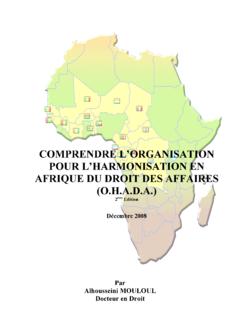Transcription of Agribusiness Commercial Legal and Institutional …
1 AgCLIR BENINA gribusiness Commercial Legal and Institutional reform AssessmentEATE nabling Agricultural TradeAgENdA foR ACtIoNfebruary 2014 AgCLIR BENIN Agribusiness Commercial Legal and Institutional reform AssessmentAgENdA foR ACtIoNfebruary 2014dISCLAIMERthe views expressed in this publication do not necessarily reflect the views of the United States Agency for International development or the United States | AgCLIR BeninBeninContentsexeCutive summary ..iList of aCronyms ..iiiintroduCtion ..1vaLue Chain summaries ..7 GettinG Credit.
2 29 PayinG taxes ..40 ComPetinG fairLy ..47aCCessinG marketinG infrastruCture ..60enforCinG ContraCts ..70 Gender and soCiaL Considerations ..79summary of reCommendations ..90february 2014 | iBeninBenin is blessed with a mix of agro-ecological zones that can support a variety of crops but suffers from a steady decline in its soil fertility and rapid Agriculture in Benin is highly dependent on rainfall, and low levels of input use, mech-anization, training, and organization among value chain actors result in the vast majority of agricultural products exiting Benin in a raw or semi-processed state.
3 Agribusinesses in Benin operate in a difficult environment characterized by high rates of formal and informal taxation and distortive market dynamics that limit the ability to access credit and engage in long-term planning for business growth. Two key overarching themes emerged over the course of the assessment, which form the basis for the recommendations at the end of this report: (1) the prevalence and heavy cost of informality and (2) the lack of effective vertical and horizontal organization along the value chain. 4 African Economic Outlook: Benin (2013).
4 The heavy Cost of informaLityApproximately 95 percent of Beninese businesses operate in the informal sector, and informal cross-border trade is estimated to represent up to 75 percent of Benin s This dynamic exacts a high cost on fiscal revenue. One study suggests that the formalization of just 5 percent of the informal economy could increase tax revenue by Businesses in the informal sector suffer as well, frequently finding it difficult to access the finance and services needed to take their operations to the next level. In Benin, this constraint is particularly burdensome on women, who make up the vast majority of informal agricultural processors and traders in all five value chains studied.
5 The causes of informality are many, but businesses cite high rates of taxation and official corruption as chief motivations for hiding in the informal sector. 5 UNCTAD, Economic Development in Africa Report (2013), available at CAPOD, Problematique d elargissement de l assiette fiscale au Benin: Analyse de la contribution des centres de gestion agree (2010).exeCutive summaryIn June July 2013, the Millennium Challenge Corporation (MCC) sponsored an Agribusiness Commercial Legal and Institutional reform (AgCLIR) diagnostic in Benin as part of the first phase of due diligence in the evaluation and refinement of the proposed Agribusiness enabling environment project under the second Compact for Benin (MCC Benin II Compact).
6 The business enabling environment (BEE) topics and value chains that are the focus of this report were selected based on the activities described in the proposed project document (the Concept Paper) prepared by the Unit de Coordination de la Formulation du Deuxi me Programme et du Suivi des R forme de MCA-B nin (UCF), which was submitted to MCC in April 2013. The AgCLIR assessment is designed to validate and further elaborate on the chief BEE obstacles facing agribusinesses in Benin. The resulting report lays out clear recommendations for reform activities to be undertaken by MCC and the UCF in the course of the MCC Benin II Compact.
7 These recommendations take into account MCC s key investment criteria and the desire to achieve broad-based, sustainable impact while keeping within MCC s time and resource | AgCLIR BeninLaCk of orGanization within the vaLue Chain One of the chief obstacles to agricultural sector growth is the dearth of effective Commercial associations and cooperative business models, whether horizontal or vertical in nature. A common refrain heard from stakeholders throughout this assessment was that commodity chains in Benin are not organized, and that this lack of organization is why they do not function effectively.
8 This repeated observation seemed, at least on a superficial level, to be at variance with another observation, namely, that there is a very large number of producer and trader associations, both commodity as well as territorially specific, across the agricultural sector. Associational density, however, does not equate with real organization or with the type of Commercial collaboration needed to promote efficiency within the value chain. In fact, the only truly successful forms of private sector organization witnessed by the assessment team were attributable to associations that seem to exist solely for the purpose of augmenting anticompetitive behavior such as price collusion and market control.
9 Poor organization increases transaction costs, limits access to finance, and prevents the application of quality standards and aggregation of supply needed to reach high-value markets. In the shea sector, for example, most women gatherers operate independently, which limits the amount they can collect as well as the price they can demand for their product. The government s Marxist-Leninist past continues to permeate the Legal framework and contribute to a top-down heavy-handed government approach to organizing agricultural sector actors that seems more focused on ensuring careful control of market dynamics and outcomes than on encouraging private sector growth.
10 Horizontal and vertical linkages within the agri-cultural sector are further impeded by lack of access to good market information and low-cost dispute resolution mecha-nisms. These factors combine to create a culture of distrust between value chain actors that encourages highly individualistic approaches to doing 2014 | iiiBeninAAFC Agriculture and Agri-Food CanadaABeNOR Agence B ninoise de NormalisationABePEC Agence B ninoise pour la Promotion des Echanges CommerciauxABSSA Agency for Food Sanitary Security of Benin (Agence B ninoise de S curite Sanitaire des Aliments)
